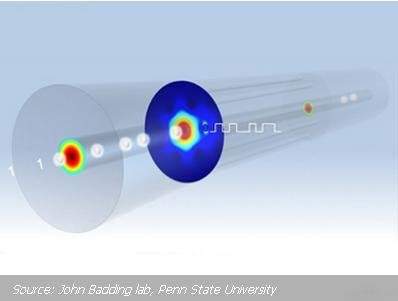Engineers have Created a Hybrid of Fiber and Chip

The group of chemists, physicists and engineers for the first time crossed optical fiber with electronics. Scientists have created a crystalline material, which allowed the element to embed chip directly into the fiber. This will help dramatically increase the speed of signal transmission.
An international team led by John Budding (John Badding), professor of chemistry at Pennsylvania State University, published his discovery in the journal Nature Photonics, reported EurekAlert.
Budding said that one of the main technological problems of telecommunications is to exchange information between optical fibers and electronic chip. So far, this transition could not be made sufficiently fast and efficient. “Optical fiber – it’s just an environment for transportation of light, and electronic devices convert light into electricity and then back into light (to monitor). There is optical-electrical-optical conversion, “- he explains. Simplify the process would be, if you create a “smart fiber”, which would serve both the fiber and chip.
Specialists from the University of Pennsylvania used a high-pressure chemical technology to deliver a semiconductor material, layer by layer, right in the lumen of the fiber. Thus, they have built into the chip component fiber. And set up just inside the active opto-electrical boundary. According to the authors, the technology does not require large expenditures.
Scientists explain that if the signal will not leave the fiber, its propagation velocity is much increased. Compound semiconductors, fiber-optic technology can be used not only in telecommunications, but also, for example, solar cells, laser technologies.
Shortlink:

Recent Comments